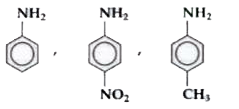Arrange the following in order of decreasing bond angles
To solve the problem of arranging the given molecules in order of decreasing bond angles, we will analyze each molecule's structure and the factors affecting bond angles.
Part (i): Arranging CH₄, NH₃, H₂O, BF₃, C₂H₂
1. CH₄ (Methane):
- Valence Electrons: Carbon (4) + 4 Hydrogens (1 each) = 8 electrons.
- Bond Pairs: 4 (C-H bonds).
- Lone Pairs: 0.
- Steric Number: 4 (4 bond pairs).
- Hybridization: sp³.
- Geometry: Tetrahedral.
- Bond Angle: 109.5°.
2. NH₃ (Ammonia):
- Valence Electrons: Nitrogen (5) + 3 Hydrogens (1 each) = 8 electrons.
- Bond Pairs: 3 (N-H bonds).
- Lone Pairs: 1.
- Steric Number: 4 (3 bond pairs + 1 lone pair).
- Hybridization: sp³.
- Geometry: Tetrahedral, but shape is trigonal pyramidal.
- Bond Angle: Approximately 107° (due to lone pair-bond pair repulsion).
3. H₂O (Water):
- Valence Electrons: Oxygen (6) + 2 Hydrogens (1 each) = 8 electrons.
- Bond Pairs: 2 (O-H bonds).
- Lone Pairs: 2.
- Steric Number: 4 (2 bond pairs + 2 lone pairs).
- Hybridization: sp³.
- Geometry: Tetrahedral, but shape is bent.
- Bond Angle: Approximately 104.5° (due to lone pair-lone pair repulsion).
4. BF₃ (Boron Trifluoride):
- Valence Electrons: Boron (3) + 3 Fluorines (7 each) = 24 electrons.
- Bond Pairs: 3 (B-F bonds).
- Lone Pairs: 0.
- Steric Number: 3 (3 bond pairs).
- Hybridization: sp².
- Geometry: Trigonal planar.
- Bond Angle: 120°.
5. C₂H₂ (Ethyne):
- Valence Electrons: 2 Carbons (4 each) + 2 Hydrogens (1 each) = 10 electrons.
- Bond Pairs: 3 (C≡C and C-H bonds).
- Lone Pairs: 0.
- Steric Number: 3 (3 bond pairs).
- Hybridization: sp.
- Geometry: Linear.
- Bond Angle: 180°.
Order of Decreasing Bond Angles:
- C₂H₂ (180°) > BF₃ (120°) > CH₄ (109.5°) > NH₃ (107°) > H₂O (104.5°)
Part (ii): Arranging NH₃, NH₂⁻, NH₄⁺
1. NH₃ (Ammonia):
- Bond Angle: Approximately 107°.
2. NH₂⁻ (Amide Ion):
- Valence Electrons: Nitrogen (5) + 2 Hydrogens (1 each) + 1 extra electron = 8 electrons.
- Bond Pairs: 2 (N-H bonds).
- Lone Pairs: 1.
- Steric Number: 3 (2 bond pairs + 1 lone pair).
- Hybridization: sp².
- Geometry: Bent.
- Bond Angle: Approximately 115° (greater than NH₃ due to less lone pair repulsion).
3. NH₄⁺ (Ammonium Ion):
- Bond Angle: 109.5° (tetrahedral).
Order of Decreasing Bond Angles:
- NH₂⁻ (approximately 115°) > NH₄⁺ (109.5°) > NH₃ (107°)
Final Answers:
1. For part (i): C₂H₂ > BF₃ > CH₄ > NH₃ > H₂O
2. For part (ii): NH₂⁻ > NH₄⁺ > NH₃
- Valence Electrons: Carbon (4) + 4 Hydrogens (1 each) = 8 electrons.
- Bond Pairs: 4 (C-H bonds).
- Lone Pairs: 0.
- Steric Number: 4 (4 bond pairs).
- Hybridization: sp³.
- Geometry: Tetrahedral.
- Bond Angle: 109.5°.
- Valence Electrons: Nitrogen (5) + 3 Hydrogens (1 each) = 8 electrons.
- Bond Pairs: 3 (N-H bonds).
- Lone Pairs: 1.
- Steric Number: 4 (3 bond pairs + 1 lone pair).
- Hybridization: sp³.
- Geometry: Tetrahedral, but shape is trigonal pyramidal.
- Bond Angle: Approximately 107° (due to lone pair-bond pair repulsion).
- Valence Electrons: Oxygen (6) + 2 Hydrogens (1 each) = 8 electrons.
- Bond Pairs: 2 (O-H bonds).
- Lone Pairs: 2.
- Steric Number: 4 (2 bond pairs + 2 lone pairs).
- Hybridization: sp³.
- Geometry: Tetrahedral, but shape is bent.
- Bond Angle: Approximately 104.5° (due to lone pair-lone pair repulsion).
- Valence Electrons: Boron (3) + 3 Fluorines (7 each) = 24 electrons.
- Bond Pairs: 3 (B-F bonds).
- Lone Pairs: 0.
- Steric Number: 3 (3 bond pairs).
- Hybridization: sp².
- Geometry: Trigonal planar.
- Bond Angle: 120°.
- Valence Electrons: 2 Carbons (4 each) + 2 Hydrogens (1 each) = 10 electrons.
- Bond Pairs: 3 (C≡C and C-H bonds).
- Lone Pairs: 0.
- Steric Number: 3 (3 bond pairs).
- Hybridization: sp.
- Geometry: Linear.
- Bond Angle: 180°.
- C₂H₂ (180°) > BF₃ (120°) > CH₄ (109.5°) > NH₃ (107°) > H₂O (104.5°)
- Bond Angle: Approximately 107°.
- Valence Electrons: Nitrogen (5) + 2 Hydrogens (1 each) + 1 extra electron = 8 electrons.
- Bond Pairs: 2 (N-H bonds).
- Lone Pairs: 1.
- Steric Number: 3 (2 bond pairs + 1 lone pair).
- Hybridization: sp².
- Geometry: Bent.
- Bond Angle: Approximately 115° (greater than NH₃ due to less lone pair repulsion).
- Bond Angle: 109.5° (tetrahedral).
- NH₂⁻ (approximately 115°) > NH₄⁺ (109.5°) > NH₃ (107°)
1. For part (i): C₂H₂ > BF₃ > CH₄ > NH₃ > H₂O
2. For part (ii): NH₂⁻ > NH₄⁺ > NH₃
Similar Questions
Knowledge Check
The correct order of decreasing bond angles in H2S,NH3,BF3 and SiH4 is
ABF3>SiH4>H2S>NH3BBF3>SiH4>NH3>H2SCBF3>NH3>SiH4>H2SDSiH4>BF3>NH3>H2SThe decreasing order oof bond angles in BF2,NH3,PF3 and I−3 is:
AI−3>NH3>PF3>BF3BBF3>I−3>PF3>NH3CBF3>NH3>PF3>I−3DI−3>BF3>NH3>PF3
Arrange the following in order of increasing acid strength:
(a)NH3,CH4,HF,H2O (b)HCOOH,C6H5COOH.CH3COOH.
View SolutionWhich of the following has maximum bond angle ? H2O,CO2,NH3,CH4.
View SolutionWhich of the following has maximum bond angle ?
H2O,CO2,NH3,CH4
View SolutionArrange the following sets in order of their basic strength in aqueous solution :
(i) NH3,C6H5NH2,CH3NH2,(CH3)3N,(CH3)2NH
(ii) Aniline, p-nitroaniline, p-methylaniline.
View SolutionArrange the following in increasing order basic strength :
(i) C6H5−NH2,C6H5CH2−NH2,C6H5NH−CH3
(ii)
View SolutionArrange the following in decreasing order of their basic strength :
C6H5NH2,C2H5NH2,(C2H5)2NH3
View Solution
